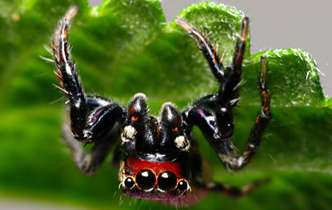Mosquito terminators and vampire spiders

Two University of Canterbury (UC) researchers' insights about two species of spider that feed preferentially on mosquitoes have been published in the Journal of Arachnology in America.
The article by Dr Fiona Cross and Professor Robert Jackson is a result of reviewing over 15 years' worth of research at UC and the International Centre of Insect Physiology and Ecology (ICIPE) in Kenya. The combined research may eventually play a part in finding the means to control human malaria.
Their findings show that two species of spider specialise on mosquitoes in strikingly different ways.
"These two spider species are highly specialised mosquito assassins," says Dr Cross, who is currently working alongside Professor Jackson on research supported by the Marsden Fund (administered by the Royal Society of New Zealand).
"Like Bram Stoker's Dracula or Arnold Schwarzenegger in the James Cameron movie The Terminator, these little specialist predators ignore any other insects that get in the way as they pursue their target victims – mosquitoes."
One species, Evarcha culicivora, like an eight-legged vampire, is particularly drawn to female mosquitoes whose guts are filled with blood. Another species, Paracyrba wanlessi, preferentially feeds on mosquito larvae lurking in pools of water inside bamboo.
Professor Jackson says while other spiders may eat mosquitoes, extensive experimental evidence has shown that only these two species can currently be characterised as mosquito specialists.
"Evarcha culicivora has a particular hankering for Anopheles mosquitoes – the very mosquitoes notorious for being malaria vectors," explains Professor Jackson.
"E. culicivora and Anopheles are both found in Kenya and are attracted to human odour (particularly the odour of dirty socks). This little spider is a predator that likes us and eats our enemies. By eating blood-filled mosquitoes, this spider also acquires a blood perfume that is attractive to members of the opposite sex," says Professor Jackson.
The two spider species come from very different habitats, with E. culicivora most often seen on walls of buildings occupied by people in East Africa and the Malaysian P. wanlessi most often found in the culms of bamboo.
Dr Cross and Professor Jackson are currently in Kenya continuing their research into the spiders, where they are pursuing the implications raised by their research. They will return to UC in August.
The Journal of Arachnology is one of the premier scientific journals presenting current research about arachnids and is published by the American Arachnological Society. The American Arachnological Society was founded in 1975 to further the study of arachnids (spiders and their relatives), and foster closer cooperation and understanding between amateur and professional arachnologists.
More information: "Mosquito-terminator spiders and the meaning of predatory specialization." www.americanarachnology.org/JoA_free/JoA_v43_n2%20/arac-43-2-123-142.pdf
Provided by University of Canterbury



















